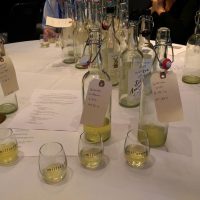Article by Toby Guidry, Certified Judge and Assistant Communication Director
Photos courtesy of Jeff Sanders, Certified Judge
Videos of the reception presentations can be accessed via our YouTube Playlist.
Opening Remarks
Gordon welcomed everyone to Baltimore and recommended people seek out Max’s Taphouse at Fells Point. He pointed out the conference was last in Baltimore 11 years ago. Part of the reason for Judge Receptions is to attract judges to help out. He pointed out the number of National or higher judges and compared it to normal competitions. He also acknowledged Jeff Sanders for coordinating events at this year’s conference.
Jeff took over MC duties and welcomed everyone to Baltimore. He pointed out the active judging community in Maryland and the surrounding areas and also spoke about the history of beer in Maryland, including brewing technology and the fight against Prohibition. He pointed out the rich resources in the beer and mead world in the area. Finally, he reviewed the judging related activities and CEP opportunities that were going to be available including proctor training and a cider workshop.
Sensory Perception of Beer
Tom Flores, Brewmaster for Brewer’s Alley, wanted to talk on his perspective on sensory evaluation. The primary senses in his view are aroma, taste, texture, and chemesthesis (astringency, etc.). Secondary senses would be sight and sound. The brain is the one responsible for sorting everything out. An example is eating potato chips. The texture and sound are synthesized in the brain for the whole experience. Personal bias can also influence how the brain processes sensory input. Perception of flavor exists in the mind. Flavor is defined by the combination of aroma, taste, and chemesthesis and how they are processed by the brain. Preconceptions, bias, confidence, fear, etc. all play a part in the way we process flavor. Color, visual, and audible cues come first. Next is aroma. Taste then follows. Finally, texture and temperature follow those. Flavor does not equal taste. Neurogastronomy is an emerging field.
Tom then turned to our intent to communicate. Why do we share our thoughts? Most people have the desire to communicate their knowledge and also learn from others. Flavor is intrinsically subjective, and not an objective truth. Brewer’s Alley Kolsch was then served to everyone. Tom then discussed lexical references. Language and our experiences determine our frame of reference for flavor descriptors. Caramel: isomaltol refers to a specific type of caramel used in cotton candy. Butter: diacetyl is often used for this frame of reference. The average beer drinker is only worried about getting a cold glass of beer. They do care about sensory attributes of beer. But they also care about identity, location, ownership, and what that brewery cares about. Bias and presuppositions and hype can all influence consumers.
Pre-Prohibition Porter
Peter Jones and Michael Stein then took us on the historical journey of Pre-Prohibition Porter which ranges from pre-1794 to 1920ish, or in other words, from Colonial era porter to early 20th century. This falls under Style Category 27 Historical Beer. Some acceptable characters, e.g. DMS or corn, may seem unusual by today’s standards.Colonial porter would have basically been brewed at home by individuals. There were probably many adjuncts used in these since people used what was available to them. In the mid-1700s, it became much more common to import beer from Europe. Robert Hare’s porter was something George Washington ordered. This would have been one of the first porter brewers in America. In the early 1800s, ale yeasts were the primary thing used for porters. The first DC brewery was opened in Funkstown in 1796. The Washington Brewery was later a fairly well advertised brewery. Pennsylvania porter became popular later in the mid-1800s. It was more likely to be fermented with a lager yeast. In some ways, it was more like a bock than what we consider porter now. There were effectively two commercial versions at one point: brewed porters and racking room porters. Brewed porters started out as recipes for porters and used dark malts in the mash for their color. Racking room porters were a different paler beer that was modified post-fermentation to give it the appearance of a porter, similar to our modern Sinimar. A 1914 Commonwealth Porter was served. It was a racking room porter which was a pale beer with Porterine added. Historically, hops were more widely produced. There were quite a few varieties of cluster, for example. Also, adjuncts like grits and corn were very commonly used. Porterine was also used to darken lighter beers to call them porters. One of the more modern Pennsylvania Porters, Yeungling, is actually a racking room porter.
Judging Flavor Additives
Jim Wagner with DuClaw was next up and some Dirty Little Freak was distributed around the room. Jim stated that their goal was to get something very similar to a Samoa Girl Scout cookie. He reminisced about discovering new styles at homebrew club meetings including an up-and-coming style called India Pale Ale. He also discussed how much equipment availability has changed.
What is an extract? Preparation of a substance containing the essence of a flavor in a concentrated form. His favorite extract is coffee. Water is the solvent being used to extract the flavor from the coffee beans. Many flavors are oil soluble and not very water soluble which makes their use in beer more complicated.
He then discussed why we use extracts. Primarily, the reason is that it’s easier to control flavor and effect. It’s easier to mitigate seasonal variations and hence easier to use fruits and flavors that aren’t in season. You can use all the tools available to you to achieve your desired result. Feel free to use a combination of real additives and extracts if the combination works better than one or the other alone. Jim then addressed a few myths about extracts.
Myths
- Using extracts is cheating – What about malt extract?
- Extracts will never catch on and be accepted – The same thing used to be said about cans.
- Extract beers taste “extracty” – Sweet Baby Jesus wins medals.
How do you judge beer with fruit or flavor extracts? The same way you judge beer that uses fruits or any additives. You don’t need to know how it was added. Judge it based on the flavors and merits of the beer.
Some things covered in the Q&A were disastrous experiments (like a Fireball beer) and using hop extracts.







